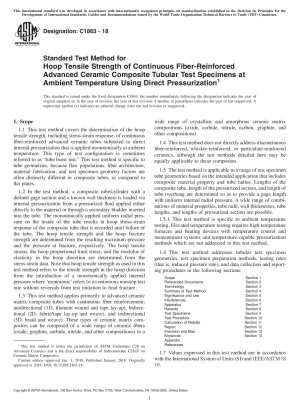ASTM C1863-18
Standard Test Method for Hoop Tensile Strength of Continuous Fiber-Reinforced Advanced Ceramic Composite Tubular Test Specimens at Ambient Temperature Using Direct Pressurization
- Standard No.
- ASTM C1863-18
- Release Date
- 2018
- Published By
- American Society for Testing and Materials (ASTM)
- Latest
- ASTM C1863-18
- Scope
- 1.1 This test method covers the determination of the hoop tensile strength, including stress-strain response, of continuous fiber-reinforced advanced ceramic tubes subjected to direct internal pressurization that is applied monotonically at ambient temperature. This type of test configuration is sometimes referred to as “tube burst test.” This test method is specific to tube geometries, because flaw populations, fiber architecture, material fabrication, and test specimen geometry factors are often distinctly different in composite tubes, as compared to flat plates. 1.2 In the test method, a composite tube/cylinder with a defined gage section and a known wall thickness is loaded via internal pressurization from a pressurized fluid applied either directly to the material or through a secondary bladder inserted into the tube. The monotonically applied uniform radial pressure on the inside of the tube results in hoop stress-strain response of the composite tube that is recorded until failure of the tube. The hoop tensile strength and the hoop fracture strength are determined from the resulting maximum pressure and the pressure at fracture, respectively. The hoop tensile strains, the hoop proportional limit stress, and the modulus of elasticity in the hoop direction are determined from the stress-strain data. Note that hoop tensile strength as used in this test method refers to the tensile strength in the hoop direction from the introduction of a monotonically applied internal pressure where ‘monotonic’ refers to a continuous nonstop test rate without reversals from test initiation to final fracture. 1.3 This test method applies primarily to advanced ceramic matrix composite tubes with continuous fiber reinforcement: unidirectional (1D, filament wound and tape lay-up), bidirectional (2D, fabric/tape lay-up and weave), and tridirectional (3D, braid and weave). These types of ceramic matrix composites can be composed of a wide range of ceramic fibers (oxide, graphite, carbide, nitride, and other compositions) in a wide range of crystalline and amorphous ceramic matrix compositions (oxide, carbide, nitride, carbon, graphite, and other compositions). 1.4 This test method does not directly address discontinuous fiber-reinforced, whisker-reinforced, or particulate-reinforced ceramics, although the test methods detailed here may be equally applicable to these composites. 1.5 The test method is applicable to a range of test specimen tube geometries based on the intended application that includes composite material property and tube radius. Lengths of the composite tube, length of the pressurized section, and length of tube overhang are determined so as to provide a gage length with uniform internal radial pressure. A wide range of combinations of material properties, tube radii, wall thicknesses, tube lengths, and lengths of pressurized section are possible. 1.5.1 This test method is specific to ambient temperature testing. Elevated temperature testing requires high-temperature furnaces and heating devices with temperature control and measurement systems and temperature-capable pressurization methods which are not addressed in this test method. 1.6 This test method addresses tubular test specimen geometries, test specimen preparation methods, testing rates (that is, induced pressure rate), and data collection and reporting procedures in the following sections: Scope Section 1 Referenced Documents Section 2 Terminology Section 3 Summary of Test Method Section 4 Significance and Use Section 5 Interferences Section 6 Apparatus Section 7 Hazards Section 8 Test Specimens Section 9 Test Procedure Section 10 Calculation of Results Section 11 Report Section 12 Precision and Bias Section 13 Keywords Section 14 Appendix References 1.7 Values expressed in this test method are in accordance with the International System of Units (SI) and IEEE/ASTM SI 10. 1 This test method is under the jurisdiction of ASTM Committee C28 on Advanced Ceramics and is the direct responsibility of Subcommittee C28.07 on Ceramic Matrix Composites. Current edition approved Jan. 1, 2018. Published January 2018. Originally approved in 2018. DOI: 10.1520/C1863-18. Copyright © ASTM International, 100 Barr Harbor Drive, PO Box C700, West Conshohocken, PA 19428-2959. United States This international standard was developed in accordance with internationally recognized principles on standardization established in the Decision on Principles for the Development of International Standards, Guides and Recommendations issued by the World Trade Organization Technical Barriers to Trade (TBT) Committee. 1 1.8 This standard does not purport to address all of the safety concerns, if any, associated with its use. It is the responsibility of the user of this standard to establish appropriate safety, health, and environmental practices and determine the applicability of regulatory limitations prior to use. Specific hazard statements are given in Section 8. 1.9 This international standard was developed in accordance with internationally recognized principles on standardization established in the Decision on Principles for the Development of International Standards, Guides and Recommendations issued by the World Trade Organization Technical Barriers to Trade (TBT) Committee.
ASTM C1863-18 Referenced Document
- ASTM C1145 Standard Terminology of Advanced Ceramics
- ASTM C1239 Standard Practice for Reporting Uniaxial Strength Data and Estimating Weibull Distribution Parameters for Advanced Ceramics*, 2018-07-01 Update
- ASTM D3878 Standard Terminology Composite Materials
- ASTM E1012 Standard Practice for Verification of Specimen Alignment Under Tensile Loading
- ASTM E337 Standard Test Method for Measuring Humidity with a Psychrometer (the Measurement of Wet- and Dry-Bulb Temperatures)
- ASTM E4 Standard Practices for Force Verification of Testing Machines
- ASTM E6 Standard Terminology Relating to Methods of Mechanical Testing
- ASTM E83 Standard Practice for Verification and Classification of Extensometer
- IEEE/ASTM SI 10 American National Standard for Metric Practice
ASTM C1863-18 history
- 2018 ASTM C1863-18 Standard Test Method for Hoop Tensile Strength of Continuous Fiber-Reinforced Advanced Ceramic Composite Tubular Test Specimens at Ambient Temperature Using Direct Pressurization
